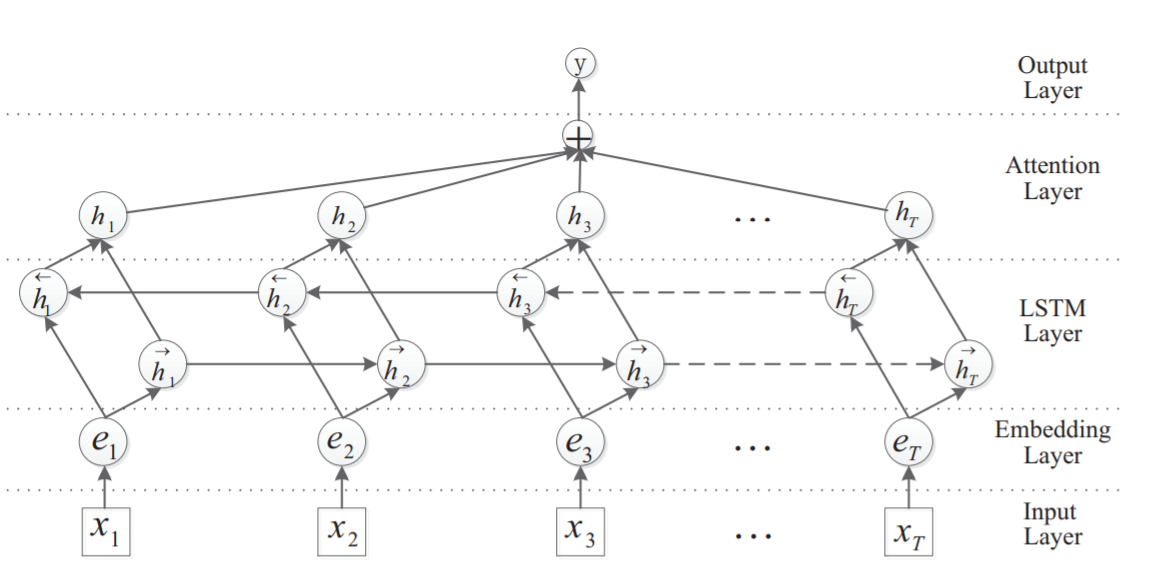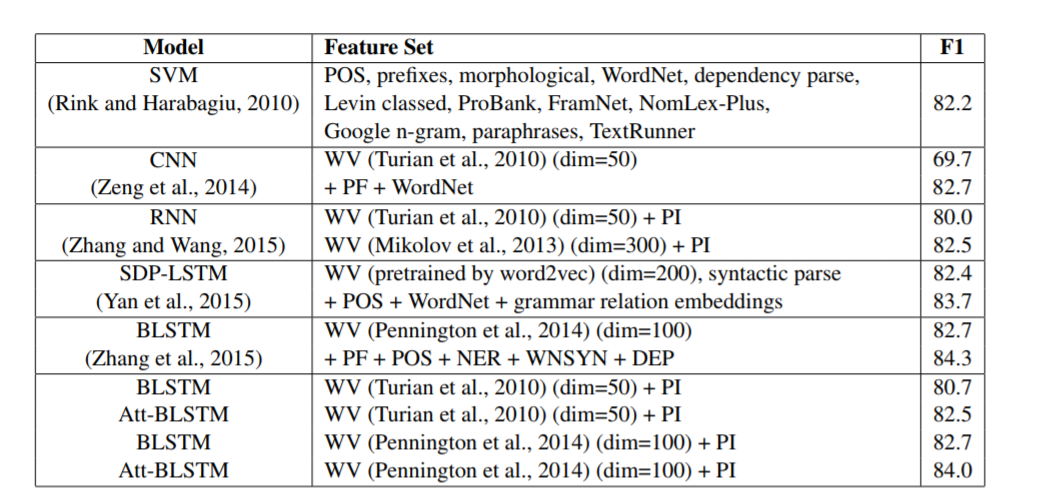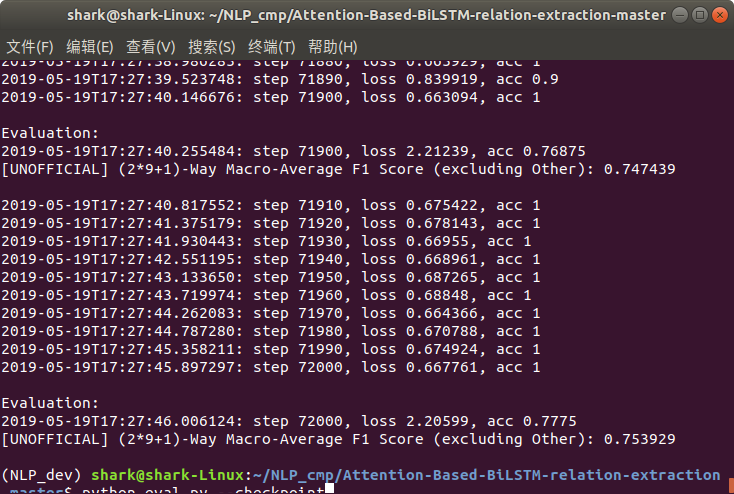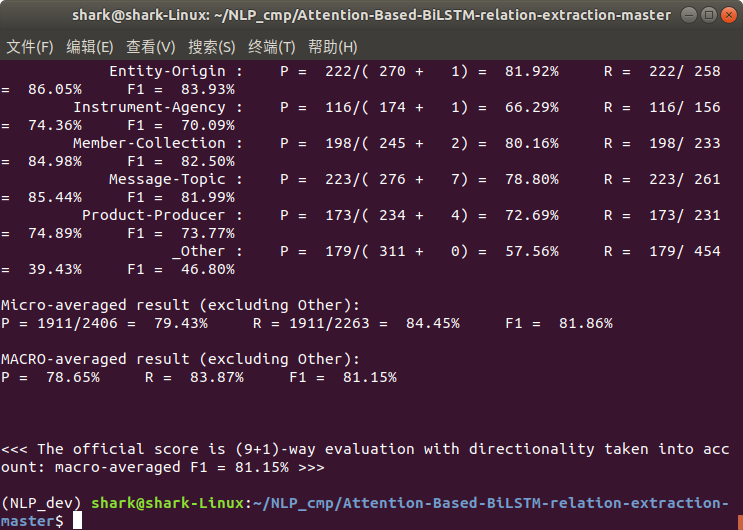关系抽取论文笔记2: Attention-Based Bidirectional Long Short-Term Memory Networks for Relation Classification
Author: Peng Zhou, Wei Shi, Jun Tian, Zhenyu Qi∗ , Bingchen Li, Hongwei Hao, Bo Xu
中科院自动化所
来源:ACL16
2.1 研究动机
本文是关系抽取非常经典的一个工作,也是在非远程标注数据集上一个比较成熟的工作(预训练语言模型之前)。本文的主要动机是将当时在NLP的很多任务上成功应用的BiLSTM+attention架构应用到关系抽取,这个框架的好处是完全的端到端,不用做任何的特征工程。上一篇的CNN虽然减少了很多特征选择的工作,但还是精心设计了词汇特征和句子特征,特别是在lexical和 sentence的特征中还分布选取了义原上为词和位置编码,而本文则是完全的端到端。
2.2 研究方法
本文采用的方法从架构上来看,从输入层向上,先是一个词嵌入,然后是两个并行的LSTM层(前项+后项),结果拼接之后过一个attention层,之后送入softmax层,得到最后的关系分类,如下图所示:

代码还是比较清晰的:
def attention(inputs):
# Trainable parameters
hidden_size = inputs.shape[2].value
u_omega = tf.get_variable("u_omega", [hidden_size], initializer=tf.keras.initializers.glorot_normal())
with tf.name_scope('v'):
v = tf.tanh(inputs)
# For each of the timestamps its vector of size A from `v` is reduced with `u` vector
vu = tf.tensordot(v, u_omega, axes=1, name='vu') # (B,T) shape
alphas = tf.nn.softmax(vu, name='alphas') # (B,T) shape
# Output of (Bi-)RNN is reduced with attention vector; the result has (B,D) shape
output = tf.reduce_sum(inputs * tf.expand_dims(alphas, -1), 1)
# Final output with tanh
output = tf.tanh(output)
return output, alphas
class AttLSTM:
def __init__(self, sequence_length, num_classes, vocab_size, embedding_size, hidden_size, l2_reg_lambda=0.0):
# Placeholders for input, output and dropout
self.input_text = tf.placeholder(tf.int32, shape=[None, sequence_length], name='input_text')
self.input_y = tf.placeholder(tf.float32, shape=[None, num_classes], name='input_y')
self.emb_dropout_keep_prob = tf.placeholder(tf.float32, name='emb_dropout_keep_prob')
self.rnn_dropout_keep_prob = tf.placeholder(tf.float32, name='rnn_dropout_keep_prob')
self.dropout_keep_prob = tf.placeholder(tf.float32, name='dropout_keep_prob')
initializer = tf.keras.initializers.glorot_normal
# Word Embedding Layer, 模型这里没有添加位置编码
with tf.device('/cpu:0'), tf.variable_scope("word-embeddings"):
self.W_text = tf.Variable(tf.random_uniform([vocab_size, embedding_size], -0.25, 0.25), name="W_text")
self.embedded_chars = tf.nn.embedding_lookup(self.W_text, self.input_text)
# Dropout for Word Embedding
with tf.variable_scope('dropout-embeddings'):
self.embedded_chars = tf.nn.dropout(self.embedded_chars, self.emb_dropout_keep_prob)
# Bidirectional LSTM
with tf.variable_scope("bi-lstm"):
_fw_cell = tf.nn.rnn_cell.LSTMCell(hidden_size, initializer=initializer())
fw_cell = tf.nn.rnn_cell.DropoutWrapper(_fw_cell, self.rnn_dropout_keep_prob)
_bw_cell = tf.nn.rnn_cell.LSTMCell(hidden_size, initializer=initializer())
bw_cell = tf.nn.rnn_cell.DropoutWrapper(_bw_cell, self.rnn_dropout_keep_prob)
self.rnn_outputs, _ = tf.nn.bidirectional_dynamic_rnn(cell_fw=fw_cell,cell_bw=bw_cell,inputs=self.embedded_chars,sequence_length=self._length(self.input_text),dtype=tf.float32)
self.rnn_outputs = tf.add(self.rnn_outputs[0], self.rnn_outputs[1])
# Attention
with tf.variable_scope('attention'):
self.attn, self.alphas = attention(self.rnn_outputs)
# Dropout
with tf.variable_scope('dropout'):
self.h_drop = tf.nn.dropout(self.attn, self.dropout_keep_prob)
# Fully connected layer
with tf.variable_scope('output'):
self.logits = tf.layers.dense(self.h_drop, num_classes, kernel_initializer=initializer())
self.predictions = tf.argmax(self.logits, 1, name="predictions")
# Calculate mean cross-entropy loss
with tf.variable_scope("loss"):
losses = tf.nn.softmax_cross_entropy_with_logits_v2(logits=self.logits, labels=self.input_y)
self.l2 = tf.add_n([tf.nn.l2_loss(v) for v in tf.trainable_variables()])
self.loss = tf.reduce_mean(losses) + l2_reg_lambda * self.l2
# Accuracy
with tf.variable_scope("accuracy"):
correct_predictions = tf.equal(self.predictions, tf.argmax(self.input_y, 1))
self.accuracy = tf.reduce_mean(tf.cast(correct_predictions, tf.float32), name="accuracy")
# Length of the sequence data
@staticmethod
def _length(seq):
relevant = tf.sign(tf.abs(seq))
length = tf.reduce_sum(relevant, reduction_indices=1)
length = tf.cast(length, tf.int32)
return length
2.3 实验结果
实验的结果在当时得到了STOA,F1 达到84%,比上一篇的CNN的方法提高了2%。具体结果如下图:

2.4 创新点
本文的主要创新点有:
- 应用了在Transformer和预训练模型框架出现前,效果最好的端到端框架LSTM+attention
- 取得了数据集上的STOA
2.5 个人点评
- 小细节,本文Bilstm中前后两层lstm在输出的时候用的element wise add的,而不是通常采取的直接拼接。考虑的因素可能是维度低一点,参数量也相对少一点,且原理上差距不大,而且本文的实验数据集样本数其实还是比较小的。
- 思路上,本文的贡献一直强调端到端,没有特征工程。其实个人觉得特征工程未必就不可取,在好的模型中叠加可用的特征工程,如果能有效调优,至少工程上是一定会用的。端到端只是因为在文本的很多场景下,无法判断那些特征是真正好的特征。但是对于关系抽取这个任务,词和实体的距离编码的位置特征已经被证明是一个充分有效的特征。
2.6 模型调试心得
2.6.1 模型地址
主要参考了https://github.com/SeoSangwoo/Attention-Based-BiLSTM-relation-extraction.git,这里感谢代码贡献者。
2.6.2 模型运行环境
tensorflow 1.4.0+
python 3.5+
nltk
glove 预训练词向量
2.6.3 数据集选择与下载
数据集是文章的dataset: SemEval2010 task8
2.6.4 模型运行步骤
1)训练 python train.py --embedding_path “{词向量路径}”

2 测试 python eval.py --checkpoint_dir “runs/1523902663/checkpoints/”

2.6.5 代码遇到的小问题
一个小问题 ,就是如果nltk安装的时候,没有下载数据,可能会运行报错。解决方法
python -> import nltk -> nltk.download(‘punkt’)
其中,nltk.tokenize.punkt中包含了很多预先训练好的tokenize模型。详见Dive into NLTK II. 具体应用如下:
import nltk.data
tokenizer = nltk.data.load(‘tokenizers/punkt/english.pickle’)
tokenizer.tokenize(text)
2.6.6 模型点评
这个实现的写法异常熟悉,和常见的textrnn几乎一模一样。一个奇怪的地方是,他没有固定embedding层,而是一起训练,我感觉没有充分利用预训练模型,且输入层没有加入位置编码,所以最终f1只有81.15,略低于文章所说。
最后
以上就是勤奋草莓最近收集整理的关于关系抽取专题(二)Attention-Based Bidirectional Long Short-Term Memory Networks for Relation Classification关系抽取论文笔记2: Attention-Based Bidirectional Long Short-Term Memory Networks for Relation Classification的全部内容,更多相关关系抽取专题(二)Attention-Based内容请搜索靠谱客的其他文章。

![[ACL2016]Attention-Based Bidirectional Long Short-Term Memory Networks for Relation Classification](https://file2.kaopuke.com:8081/files_image/reation/bcimg14.png)






发表评论 取消回复